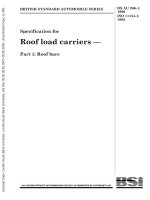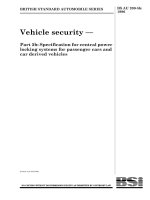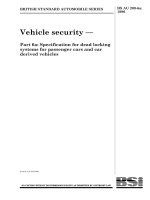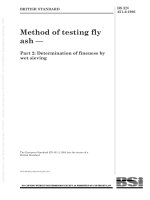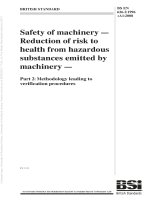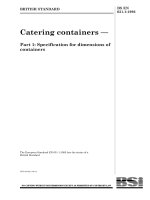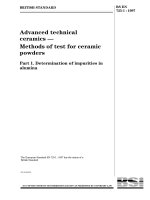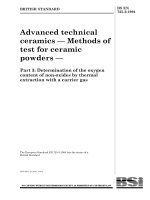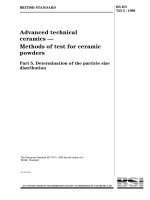Bsi bs en 00725 6 1996 (1999)
Bạn đang xem bản rút gọn của tài liệu. Xem và tải ngay bản đầy đủ của tài liệu tại đây (703.57 KB, 18 trang )
BRITISH STANDARD
Advanced technical
ceramics —
Methods of test for
ceramic powders —
Part 6: Determination of the specific
surface area
The European Standard EN 725-6:1996 has the status of a
British Standard
ICS 81.060.10
BS EN
725-6:1996
BS EN 725-6:1996
Committees responsible for this
British Standard
The preparation of this British Standard was entrusted to Technical
Committee RPI/13, Advanced technical ceramics, upon which the following
bodies were represented:
AEA Technology
Aluminium Federation
British Ceramic Research Ltd.
British Industrial Ceramic Manufacturers’ Association
Department of Trade and Industry (National Physical Laboratory)
Flat Glass Manufacturers’ Association
GAMBICA (BEAMA Ltd.)
Institute of Refractories Engineers
Ministry of Defence
Refractories Association of Great Britain
Society of British Aerospace Companies Ltd.
University of Manchester
This British Standard, having
been prepared under the
direction of the Sector Board
for Materials and Chemicals,
was published under the
authority of the Standards
Board and comes into effect on
15 September 1996
© BSI 07-1999
The following BSI references
relate to the work on this
standard:
Committee reference RPI/13
Draft for comment 92/49116 DC
ISBN 0 580 25842 4
Amendments issued since publication
Amd. No.
Date
Comments
BS EN 725-6:1996
Contents
Committees responsible
National foreword
Foreword
Text of EN 725-6
© BSI 07-1999
Page
Inside front cover
ii
2
3
i
BS EN 725-6:1996
National foreword
This British Standard has been prepared by Technical Committee RPI/13 and is
the English language version of EN 725-6:1996 Advanced technical ceramics —
Methods of test for ceramic powders — Part 6: Determination of the specific
surface area published by the European Committee for Standardization (CEN).
EN 725-6:1996 was produced as a result of international discussions in which the
UK took an active part.
NOTE International and European Standards as well as overseas standards, are available from
Customer Services, BSI, 389 Chiswick High Road, London, W4 4AL.
A British Standard does not purport to include all the necessary provisions of a
contract. Users of British Standards are responsible for their correct application.
Compliance with a British Standard does not of itself confer immunity
from legal obligations.
Summary of pages
This document comprises a front cover, an inside front cover, pages i and ii,
the EN title page, pages 2 to 13 and a back cover.
This standard has been updated (see copyright date) and may have had
amendments incorporated. This will be indicated in the amendment table on the
inside front cover.
ii
© BSI 07-1999
EUROPEAN STANDARD
EN 725-6
NORME EUROPÉENNE
January 1996
EUROPÄISCHE NORM
ICS 81.060.10
Descriptors: Ceramics, powdery materials, tests, determination, specific area, absorption, nitrogen
English version
Advanced technical ceramics — Methods of test for ceramic
powders —
Part 6: Determination of the specific surface area
Céramiques techniques avancées — Méthodes
d’essai pour les poudres céramiques —
Partie 6: Détermination de la surface spécifique
Hochleistungskeramik — Prüfverfahren für
keramische Pulver —
Teil 6: Bestimmung der spezifischen Oberfläche
www.bzfxw.com
This European Standard was approved by CEN on 1995-11-02. CEN members
are bound to comply with the CEN/CENELEC Internal Regulations which
stipulate the conditions for giving this European Standard the status of a
national standard without any alteration.
Up-to-date lists and bibliographical references concerning such national
standards may be obtained on application to the Central Secretariat or to any
CEN member.
This European Standard exists in three official versions (English, French,
German). A version in any other language made by translation under the
responsibility of a CEN member into its own language and notified to the
Central Secretariat has the same status as the official versions.
CEN members are the national standards bodies of Austria, Belgium,
Denmark, Finland, France, Germany, Greece, Iceland, Ireland, Italy,
Luxembourg, Netherlands, Norway, Portugal, Spain, Sweden, Switzerland and
United Kingdom.
CEN
European Committee for Standardization
Comité Européen de Normalisation
Europäisches Komitee für Normung
Central Secretariat: rue de Stassart 36, B-1050 Brussels
© 1996 All rights of reproduction and communication in any form and by any means reserved in all
countries to CEN and its members.
Ref. No. EN 725-6:1996 E
EN 725-6:1996
Foreword
This European Standard was prepared by
CEN/TC184, Advanced technical ceramics, the
Secretariat of which is held by BSI.
This European Standard shall be given the status of
a national standard or by endorsement, at the latest
by July 1996, and conflicting national standards
shall be withdrawn at the latest by July 1996.
The method given is closely based on ISO 8008:1987
Aluminium oxide primarily used for the production
of aluminium — Determination of specific surface
area by nitrogen absorption (single point method),
published by the International Organization for
Standardization (ISO).
EN 725 Advanced technical ceramics — Methods of
test for ceramic powders, consists of eleven Parts:
— Part 1: Determination of impurities in
alumina;
— Part 2: Determination of impurities in barium
titanate (ENV);
— Part 3: Determination of oxygen content of
non-oxides by thermal extraction;
— Part 4: Determination of oxygen content of
non-oxides by XRF analysis (ENV);
— Part 5: Determination of particle size
distribution;
— Part 6: Determination of specific surface area;
— Part 7: Determination of absolute density;
— Part 8: Determination of tapped density;
— Part 9: Determination of untamped bulk
density;
— Part 10: Determination of compaction
properties;
— Part 11: Determination of the densification on
natural sintering (ENV).
In accordance with the Common CEN/CENELEC
Rules, the following countries are bound to
implement this European Standard: Austria,
Belgium, Denmark, Finland, France, Germany,
Greece, Iceland, Ireland, Italy, Luxembourg,
Netherlands, Norway, Portugal, Spain, Sweden,
Switzerland, United Kingdom.
2
Contents
Foreword
1
Scope
2
Principle
3
Apparatus
4
Procedure
5
Expression of results
6
Test report
Figure 1 — Adsorption apparatus
Figure 2 — Thermostat for the heating of
the adsorption bottles in the desorption
procedure
Figure 3 — Additional device for
degassing under vacuum
Figure 4 — Nomogram
Table 1 — Recommended masses of sample
Table 2 — B1, B2 = f(Tz)
Table 3 — Quantities and symbols
Page
2
3
3
3
6
8
13
4
4
6
12
7
10
11
www.bzfxw.com
© BSI 07-1999
EN 725-6:1996
1 Scope
This Part of EN 725 specifies a method for the determination of the specific surface area of powders used
for technical ceramics, by a nitrogen adsorption, single-point method.
The method is limited to the measurement of surface areas of over 1 m2/g.
2 Principle
The method is based on the property of the solids to adsorb gas molecules at their surface.
In the range between 0,05 to 0,3 times the saturation vapour pressure of the measuring gas, the multilayer
adsorption begins. The formation of the first monolayer of adsorbed molecules can be detected from the
behaviour of the adsorption isotherm in this range; this is the only process relevant to the present method.
Nitrogen is introduced at ambient temperature and at atmospheric pressure into two bottles of equal
volume, one of which contains the test portion while the other is empty. The connected bottles are
immersed in a refrigerant bath of liquid nitrogen. Since some nitrogen is adsorbed by the sample, a
differential pressure occurs between the two bottles and is measured by means of a differential manometer.
From this difference, the number of molecules adsorbed on the surface is calculated.
This number is multiplied by the known area occupied by a single adsorbed molecule so that the total
surface area is obtained. The area occupied by an adsorbed nitrogen molecule is taken as 16,2 × 10–20 m2.
3 Apparatus
3.1 Adsorption apparatus (see Figure 1)
The apparatus consists of a reference bottle (7) and a sample adsorption bottle (8) which are moved on to
the two connecting pieces, with sealing rings in between to make the joint gas-tight. At each connecting
piece, there is a valve (1 and 2), by which the bottles can be connected to the atmosphere. The measuring
gas is admitted to the bottle through the capillaries inside the connecting pieces.
The bottles, made of shock-resisting glass, have a volume of about 100 cm3. The difference between the
volume of the two bottles shall not exceed 0,1 %. The necks of the bottles consist of calibrated glass tubes
with an internal diameter of 9 mm ± 0,02 mm. Each tube has an upper and lower mark.
In this way, several bottles can be used as either sample or reference bottles without compensating the
volumes for each combination of bottles. A differential manometer containing dibutyl phthalate is arranged
between the two bottles. The legs of the differential manometer are connected to the two inlet capillaries
of the adsorption bottles. By means of the valve 4, the two bottles, i.e. the two inlet capillaries, can be
separated from or connected to each other. By means of the valve 5, the liquid in the two legs of the
differential manometer can be separated or connected. The legs of the differential manometer consist of
calibrated glass tubes with an internal diameter of 5 mm ± 0,02 min. This ensures that the change in
volume during the adsorption measurement can be calculated with sufficient accuracy. The inlet capillary
of the sample bottle, being the shorter of the two, is connected to a compensating volume (10), which is
adjusted during preparation of the apparatus.
The measuring gas is admitted to the apparatus via the valve 3. If the valves 1, 2 and 4 are open, the
measuring gas is passed through both bottles. If the valves 1 and 4 are closed, the reference bottle is shut
off and only the sample bottle is purged with the measuring gas.
During measurement, only a part of the gas volume, which is downstream of the valve 3 and upstream of
the valves 1 and 2, is cooled by liquid nitrogen to the measuring temperature. The gas volume remaining
at room temperature shall be limited to 10 % of the total volume at maximum. For this reason, the
connections to the adsorption bottles are capillaries, which occupy most of the necks of the bottles in order
to keep the portion remaining at room temperature as small as possible.
The adsorption bottle has calibrated volume of 100 cm3. To facilitate weighing of the sample as well as the
cleaning of the adsorption bottle, two-piece bottles are applied. The two pieces are connected by ground
joints and fixed by hooks and springs.
3.2 Thermostat, for heating the adsorption bottles in the desorption procedure (see 4.3 and Figure 2).
3.3 Device, for degassing under vacuum (see Figure 3).
3.4 Cooling bath, containing boiling nitrogen.
3.5 Water bath, capable of being controlled at 22 °C ± 3 °C or at approximately 40 °C, as required.
www.bzfxw.com
© BSI 07-1999
3
EN 725-6:1996
www.bzfxw.com
Figure 1 — Adsorption apparatus
4
© BSI 07-1999
EN 725-6:1996
www.bzfxw.com
Figure 2 — Thermostat for the heating of the adsorption bottles in the desorption procedure
© BSI 07-1999
5
EN 725-6:1996
www.bzfxw.com
Figure 3 — Additional device for degassing under vacuum
4 Procedure
4.1 Test portion
Choose the mass of sample to be used depending on the supposed specific surface area.
Recommended values are given in Table 1.
6
© BSI 07-1999
EN 725-6:1996
Table 1 — Recommended masses of sample
Supposed specific surface area
Mass of sample
2 –1
g
m g
1
5
5
3
10
2
50
from 0,7 to 1,0
100
from 0,2 to 0,3
NOTE
If the surface area is completely unknown, preliminary tests are necessary to find the best test portion.
4.2 Preparation of apparatus
4.2.1 Checking of new apparatus
4.2.1.1 General
New apparatus shall be checked to ensure that the compensating volume (10) is adjusted correctly and that
the apparatus is gas-tight.
4.2.1.2 Checking the equalization of volumes
The valve 4 shall be gas-tight when the equalization of the volumes is checked.
Fit the empty adsorption bottles to the connecting pieces; the upper mark of the bottle neck shall coincide
with the lower sealing ring. Purge the apparatus with nitrogen by opening all the valves and allowing the
gas to flow at approximately 10 1/h. During purging, the bottles are immersed in the water bath (see 3.5),
up to the lower mark on the neck, in order to bring them to the set temperature of 22 °C ± 3 °C. When the
equalization of the temperature can be assumed (after at least 5 min), shut off the apparatus from the
atmosphere and shut off the two bottles from each other, by closing the valves in the sequence 1, 2, 3 and 4.
On shutting the valve 4, a small pressure difference can appear.
If this pressure difference changes within the next 2 min, a complete temperature equalization has not
been reached in the adsorption bottles. In this case, open the valves again in the sequence 4, 3, 2 and 1, and
purge the apparatus further with nitrogen. After a few minutes, repeat this check. If temperature
equalization is achieved, close valve 5.
Remove the bottles from the water bath, dry any drops of water adhering to them, and immerse the bottles
up to the lower mark in the cooling bath (see 3.4). When the bottles have attained the temperature of the
boiling nitrogen (with empty bottles after about 1 min), open the valve 5 slowly If the volumes of the sample
and reference sides have been fully equalized, no pressure difference occurs. In this case, close the valve 5
again and open the valve 4. Then remove the cooling bath and replace it by the water bath (see 3.5),
maintained at approximately 40 °C, to thaw out the bottles. Remove the warm water bath as soon as the
bottles have reached ambient temperature again. After 2 min, reopen the valves 3, 2 and 1 in that
sequence, and purge the apparatus with nitrogen. During the cooling and heating of the bottles, great
pressure differences may occur momentarily so that the measuring liquid in the manometer may be
transferred into other parts of the apparatus. For this reason, do not open the valve 5 before temperature
equalization.
If the pressure difference should occur during the preparation of the apparatus, change the compensating
volume (10) in such a way that the volumes on both sides of the differential manometer are equal. To check
the equalization of the volumes, repeat the test described above.
4.2.1.3 Checking of tightness
If, after the slow opening of valve 5, steadily increasing or very great pressure differences occur (more
than 400 mm of liquid column), during the equalization of volume at the temperature of boiling nitrogen,
then the apparatus will have a leakage to the atmosphere (for instance, caused by the valves 1, 2, 3).
Leakage of valve 4 cannot be recognized by a pressure difference and the following special check shall be
carried out. Immerse the bottles in the cooling bath (see 3.4), close the valves 2, 3 and 4, and open the
valves 1 and 5. By means of valve 1, create a pressure difference of approximately 300 mm of liquid
column. Close the valve 1.
Within the next 10 min, the liquid column of the differential manometer shall not sink more than 1 mm.
© BSI 07-1999
7
EN 725-6:1996
4.2.2 Checking of functioning
When the apparatus is put into operation, and later from time to time, check its functioning by measuring
a solid with a known specific surface area. Measure the specific surface area of the test substance by the
same method.
4.2.3 Maintenance
Replace the measuring liquid of the differential manometer when it is dirty or at least every year. Change
the used drying agent in the drying tower.
4.3 Degassing of samples
Weigh the adsorption bottle and record its mass. Dry the test sample and place it in the adsorption bottle
in such a way that no powder adheres to the neck of the bottle. Weigh the bottle again.
Evacuate the bottle and sample using a pressure of about 0,01 bar. Purge intermittently with pure
nitrogen. The time necessary will vary for each type of powder and is reported (see clause 6). It is essential
that the sample is completely degassed before the adsorption measurement. Weigh the bottle again after
degassing. Then heat the bottle in the thermostat (see 3.2). The temperature used will also vary for each
type of powder and shall be reported (see clause 6).
NOTE
For example, alumina powders require approximately 30 min at 200 °C.
4.4 Adsorption measurement
Open the valves 2 and 3, pass nitrogen through the apparatus and connect the adsorption bottle filled with
the pretreated sample and nitrogen to the connecting piece. Then open the valves 1, 4 and 5, and warm the
bottles in the water bath (3.5), maintained at approximately 22 °C.
When the equilibrium pressure is attained, close the valves 1, 2, 3 and 4 and check the sample bottle and
the reference bottle for temperature equalization. If a pressure difference appears, reopen the valves in the
sequence 4, 3, 2 and 1 and continue purging with nitrogen. When temperature equalization is achieved,
close the valve 5 and shut off the nitrogen flow. Immerse the bottles in the cooling bath (see 3.4) down to
the lower mark, and open the valve 5 very slowly. If the existing pressure difference has become constant,
read off this difference to an accuracy of 0,5 mm.
NOTE The time to reach a constant pressure difference can be quite long for some materials, for example those having micropores
or a low thermal conductivity.
Report the time interval from immersion of the bottles until reading of the pressure difference.
After having finished the measurement, close the valve 5 and open the valve 4. Replace the cooling bath
(see 3.4) by the water bath (see 3.5), maintained at approximately 40 °C. After a few minutes, start the
nitrogen flow and open the valves 3, 2, 1 and 5 in that sequence. When the connecting pieces are at ambient
temperature, close the valves 1, 4 and 5 and change the sample bottle to carry out a new measurement.
5 Expression of results
5.1 Equations
The specific surface area Sm is given by the following equation:
(1)
where the symbols are as defined in Table 3.
In this equation, the single-point calculation of the BET equation has been assumed and the correcting
factor of 1,05 which represents the density of the liquid in the differential manometer introduced. For
practical purposes, (BN2, V, Vz, Tk, po have been taken as constants. In addition, the expression Vz¹p/Tz is
small compared with the other terms of the sum in the first square brackets and has been neglected.
Incorporating the numerical values and the units given in Table 3, the following numerical equation is
obtained with Tz = 295 K for calculating the mass-related surface area:
(2)
8
© BSI 07-1999
EN 725-6:1996
The second, Vp containing term of the sum of this equation can be neglected, if the specific surface areas
Sm are $ 10 m2g–1. The equilibrium pressure p in equation (2) is calculated according to the following unit
equation:
(3)
where
%p = Ôg%h
(4)
For practical purposes,
are taken as constants. Incorporating the numerical values and units given in Table 3, the following
numerical equation is obtained at Tz = 295 K:
p = 0,278pB – 1,025 × 10–4%h
(5)
If Tz deviates from Tz = 295 K by more than ± 3 K, the two constants in equations (2) and (5) have to be
corrected and the actual room temperature Tz shall be taken into account:
(6)
p = B2pB – 1,025 × 10–4 %h
(7)
Incorporating the numerical values and the units given in Table 3, one obtains for B1 and B2:
(8)
(9)
where the symbols and constants used have the meanings shown in Table 3.
© BSI 07-1999
9
EN 725-6:1996
Table 2 — B1, B2 = f(Tz)
B1 × 105
Tz in K
B2 × 10
291
6,747
2,817
292
6,724
2,807
293
6,701
2,798
294
6,678
2,789
295
6,656
2,780
296
6,633
2,770
297
6,611
2,761
298
6,588
2,752
299
6,566
2,743
300
6,544
2,734
301
6,523
2,725
302
6,501
2,717
303
6,480
2,708
304
6,458
2,699
305
6,437
2,691
306
6,416
2,682
307
6,395
2,673
308
6,374
2,666
5.2 Calculation by means of a nomogram
The calculation may be simplified using the nomogram indicated in Figure 4.
Knowing the atmospheric pressure and the pressure difference read off on the differential manometer, the
factor A is taken from the nomogram (see Figure 4).
The specific surface area of the sample, expressed in square metres per gram, is given by the formula:
S m = A¹h
-------------m
(10)
where:
¹h
is the pressure difference, in millimetres;
m
is the mass, in grams, of the test portion.
The nomogram allows the calculation of specific surface area in the range from 10 m2·g–1 to 300 m2·g–1
approximately.
For values less than 10 m2·g–1 or greater than 300 m2·g–1, which are generally not of interest in the
ceramics industry, use equations (6) and (7) for the calculation.
5.3 Precision
Repeatability:
± 0,5 %
Reproducibility:
±1%
NOTE
10
These figures are repeated from the International standard mentioned in the foreword.
© BSI 07-1999
EN 725-6:1996
Table 3 — Quantities and symbols
Symbol
Quantity
Unit
Sm
Mass-related surface area
m2·g–1
p
Equilibrium pressure
bar
%h
Difference in height on the differential manometer
mm
Vp
Volume of the solid sample
cm3
m
Mass of the test portion
g
pB
Filling pressure (atmospheric pressure)
bar
po
Saturation pressure of boiling nitrogen (po = 1,05 bar)
bar
NL
Loschmidt number. Avogadro constant (NL = 6,023 × 1023 mol–1)
mol–1
R
Molar gas constant (R = 8,314 j·mol–1·K–1)
j·mol ·K–1
Ô
Density of dibutyl phthalate (Ô = 1,05 g·cm–3)
g·cm
g
Acceleration of free fall (g = 981 cm·s–2)
cm·s–2
BN 2
Area occupied by a nitrogen molecule ( B N2 = 16,2 × 1020 m2)
m2
V
Volume of the adsorption bottle, into which the capillary is introduced, up to cm3
the level of the cooling bath (V = 101,2 cm3)
Vz
Volumes of the sample part and the reference part from the level of the
cooling bath to the zero level of the differential manometer. (These volumes
remain at room temperature during measurement.) (Vz = 8,35 cm3)
cm3
Vx
Change of volume in one leg of the differential manometer during
measurement
cm3
r
Internal radius of the tube of the differential manometer (r = 0,25 cm)
cm
TK
Temperature of the cooling bath (4.4) (TK = 77,6 K)
K
Tz
Ambient temperature and temperature of the water bath (4.5)
K
%p
Pressure difference
bar
B1
B2
© BSI 07-1999
Abbreviations, see equations (8) and (9)
11
EN 725-6:1996
To determine the factor A, connect by means of a ruler the pressure difference at equilibrium %h on the left-hand scale with the
barometric pressure pB on the right-hand scale. Read off the factor A at the interrupt of the straight connecting line with the
centre scale.
Figure 4 — Nomogram
12
© BSI 07-1999
EN 725-6:1996
6 Test report
The test report shall contain the following information:
a) the name of the testing establishment;
b) date of the test, report identification and number, operator, signatory;
c) a reference to this European standard, i.e. determined in accordance with EN 725-6;
d) a description of the powder (material type, manufacturer, batch or code number);
e) pre-treatment of the sample: temperature and time of preliminary drying, temperature and time of
desorption heating, application of nitrogen or of vacuum during desorption heating;
f) the atmospheric pressure during the measurement, temperature of the water bath during the
measurement, time from immersion of the adsorption bottles in the cooling bath until reading of the
pressure difference;
g) the difference in height which is read from the differential manometer;
h) the specific surface area of the sample and, where required, the mean value and its standard
deviation;
i) comments about the test or test results.
© BSI 07-1999
13
BS EN
725-6:1996
BSI — British Standards Institution
BSI is the independent national body responsible for preparing
British Standards. It presents the UK view on standards in Europe and at the
international level. It is incorporated by Royal Charter.
Revisions
British Standards are updated by amendment or revision. Users of
British Standards should make sure that they possess the latest amendments or
editions.
It is the constant aim of BSI to improve the quality of our products and services.
We would be grateful if anyone finding an inaccuracy or ambiguity while using
this British Standard would inform the Secretary of the technical committee
responsible, the identity of which can be found on the inside front cover.
Tel: 020 8996 9000. Fax: 020 8996 7400.
BSI offers members an individual updating service called PLUS which ensures
that subscribers automatically receive the latest editions of standards.
Buying standards
Orders for all BSI, international and foreign standards publications should be
addressed to Customer Services. Tel: 020 8996 9001. Fax: 020 8996 7001.
In response to orders for international standards, it is BSI policy to supply the
BSI implementation of those that have been published as British Standards,
unless otherwise requested.
Information on standards
BSI provides a wide range of information on national, European and
international standards through its Library and its Technical Help to Exporters
Service. Various BSI electronic information services are also available which give
details on all its products and services. Contact the Information Centre.
Tel: 020 8996 7111. Fax: 020 8996 7048.
Subscribing members of BSI are kept up to date with standards developments
and receive substantial discounts on the purchase price of standards. For details
of these and other benefits contact Membership Administration.
Tel: 020 8996 7002. Fax: 020 8996 7001.
Copyright
Copyright subsists in all BSI publications. BSI also holds the copyright, in the
UK, of the publications of the internationalstandardization bodies. Except as
permitted under the Copyright, Designs and Patents Act 1988 no extract may be
reproduced, stored in a retrieval system or transmitted in any form or by any
means – electronic, photocopying, recording or otherwise – without prior written
permission from BSI.
This does not preclude the free use, in the course of implementing the standard,
of necessary details such as symbols, and size, type or grade designations. If these
details are to be used for any other purpose than implementation then the prior
written permission of BSI must be obtained.
BSI
389 Chiswick High Road
London
W4 4AL
If permission is granted, the terms may include royalty payments or a licensing
agreement. Details and advice can be obtained from the Copyright Manager.
Tel: 020 8996 7070.
